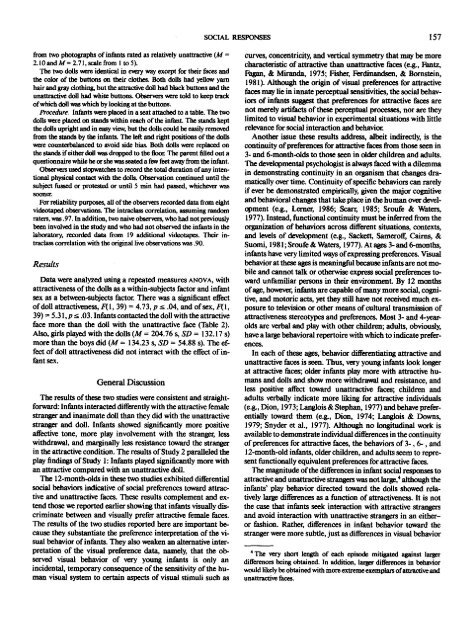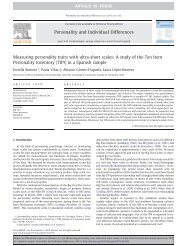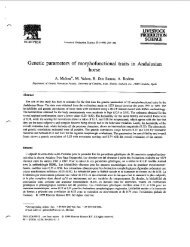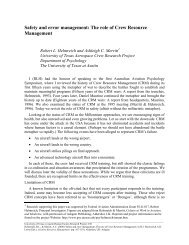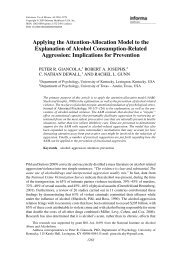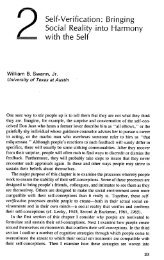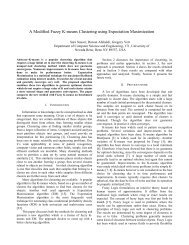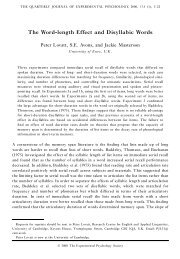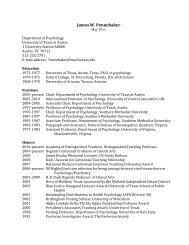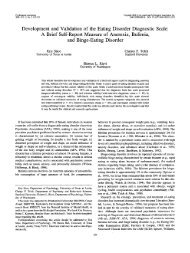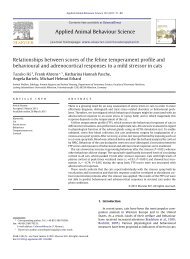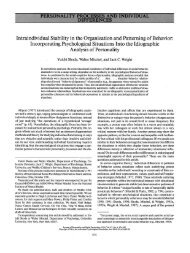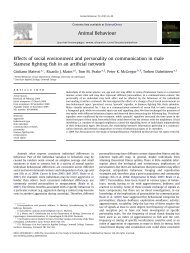Infants' differential social responses to attractive and unattractive faces
Infants' differential social responses to attractive and unattractive faces
Infants' differential social responses to attractive and unattractive faces
You also want an ePaper? Increase the reach of your titles
YUMPU automatically turns print PDFs into web optimized ePapers that Google loves.
from two pho<strong>to</strong>graphs of infants rated as relatively un<strong>attractive</strong> (M =<br />
2.10<strong>and</strong>M= 2.71, scale from I <strong>to</strong> 5).<br />
The two dolls were identical in every way except for their <strong>faces</strong> <strong>and</strong><br />
the color of the but<strong>to</strong>ns on their clotl~. Both dolls had yellow yarn<br />
hair <strong>and</strong> gray clothing, but the <strong>attractive</strong> doll had black but<strong>to</strong>ns <strong>and</strong> the<br />
un<strong>attractive</strong> doll had white but<strong>to</strong>ns. Ohsetvers were <strong>to</strong>ld <strong>to</strong> keep track<br />
of which doll was which by looking at the but<strong>to</strong>ns.<br />
Procedure. Infants were placed in a seat attached <strong>to</strong> a table. The two<br />
dolls were placed on st<strong>and</strong>s within reach of the infant. The st<strong>and</strong>s kept<br />
the dolls upright <strong>and</strong> in easy view, but the dolls could be easily removed<br />
from the st<strong>and</strong>s by the infants. The leR <strong>and</strong> right positions of the dolls<br />
were counterbalanced <strong>to</strong> avoid side bias. Both dolls were replaced on<br />
the st<strong>and</strong>s if either doll was drepped <strong>to</strong> the floor. The parent filled out a<br />
questionnaire while he or she was seated a few feet away from the infant.<br />
Observers used s<strong>to</strong>pwatches <strong>to</strong> record the <strong>to</strong>tal duration of any inten-<br />
tional physical contact with the dolls. Observation continued until the<br />
subject fussed or protested or until 5 min had passed, whichever was<br />
sooner.<br />
For reliability purposes, all of the observers recorded data from eight<br />
videotaped observations. The intraclass correlation, assuming r<strong>and</strong>om<br />
raters, was .97. In addition, two naive observers, who had not previously<br />
been involved in the study <strong>and</strong> who had not observed the infants in the<br />
labora<strong>to</strong>ry, recorded data from 19 additional videotapes. Their in-<br />
traclass correlation with the original live observations was .90.<br />
Results<br />
Data were analyzed using a repeated measures ANOVA, with<br />
<strong>attractive</strong>ness of the dolls as a within-subjects fac<strong>to</strong>r <strong>and</strong> infant<br />
sex as a between-subjects fac<strong>to</strong>r. There was a significant effect<br />
of doll <strong>attractive</strong>ness, F(l, 39) = 4.73, p < .04, <strong>and</strong> of sex, F(l,<br />
39) = 5.31, p < .03. Infants contacted the doll with the <strong>attractive</strong><br />
face more than the doll with the un<strong>attractive</strong> face (Table 2).<br />
Also, girls played with the dolls (M = 204.76 s, SD = 132.17 s)<br />
more than the boys did (M = 134.23 S, SD = 54.88 s). The ef-<br />
fect of doll <strong>attractive</strong>ness did not interact with the effect of in-<br />
fant sex.<br />
General Discussion<br />
The results of these two studies were consistent <strong>and</strong> straight-<br />
forward: Infants interacted differently with the <strong>attractive</strong> female<br />
stranger <strong>and</strong> inanimate doll than they did with the un<strong>attractive</strong><br />
stranger <strong>and</strong> doll. Infants showed significantly more positive<br />
affective <strong>to</strong>ne, more play involvement with the stranger, less<br />
withdrawal, <strong>and</strong> marginally less resistance <strong>to</strong>ward the stranger<br />
in the <strong>attractive</strong> condition. The results of Study 2 paralleled the<br />
play findings of Study 1: Infants played significantly more with<br />
an <strong>attractive</strong> compared with an un<strong>attractive</strong> doll.<br />
The 12-month-olds in these two studies exhibited <strong>differential</strong><br />
<strong>social</strong> behaviors indicative of <strong>social</strong> preferences <strong>to</strong>ward attrac-<br />
tive <strong>and</strong> un<strong>attractive</strong> <strong>faces</strong>. These results complement <strong>and</strong> ex-<br />
tend those we reported earlier showing that infants visually dis-<br />
criminate between <strong>and</strong> visually prefer <strong>attractive</strong> female <strong>faces</strong>.<br />
The results of the two studies reported here are important be-<br />
cause they substantiate the preference interpretation of the vi-<br />
sual behavior of infants. They also weaken an alternative inter-<br />
pretation of the visual preference data, namely, that the ob-<br />
served visual behavior of very young infants is only an<br />
incidental, temporary consequence of the sensitivity of the hu-<br />
man visual system <strong>to</strong> certain aspects of visual stimuli such as<br />
SOCIAL RESPONSES 157<br />
curves, concentricity, <strong>and</strong> vertical symmetry that may be more<br />
characteristic of <strong>attractive</strong> than un<strong>attractive</strong> <strong>faces</strong> (e.g., Fantz,<br />
F~n, & Mir<strong>and</strong>a, 1975; Fisher, Ferdin<strong>and</strong>sen, & Bornstein,<br />
1981). Although the origin of visual preferences for <strong>attractive</strong><br />
<strong>faces</strong> may lie in innate perceptual sensitivities, the <strong>social</strong> behav-<br />
iors of infants suggest that preferences for <strong>attractive</strong> <strong>faces</strong> are<br />
not merely artifacts of these perceptual processes, nor are they<br />
limited <strong>to</strong> visual behavior in experimental situations with little<br />
relevance for <strong>social</strong> interaction <strong>and</strong> behavior.<br />
Another issue these results address, albeit indirectly, is the<br />
continuity of preferences for <strong>attractive</strong> <strong>faces</strong> from those seen in<br />
3- <strong>and</strong> 6-month-olds <strong>to</strong> those seen in older children <strong>and</strong> adults.<br />
The developmental psychologist is always faced with a dilemma<br />
in demonstrating continuity in an organism that changes dra-<br />
matically over time. Continuity of specific behaviors can rarely<br />
if ever be demonstrated empirically, given the major cognitive<br />
<strong>and</strong> behavioral changes that take place in the human over devel-<br />
opment (e.g., Lerner, 1986; Scarr, 1985; Sroufe & Waters,<br />
1977). Instead, functional continuity must be inferred from the<br />
organization of behaviors across different situations, contexts,<br />
<strong>and</strong> levels of development (e.g., SackeR, Sameroff, Cairns, &<br />
Suomi, 1981; Sroufe & Waters, 1977). At ages 3- <strong>and</strong> 6-months,<br />
infants have very limited ways ofexpressing preferences. Visual<br />
behavior at these ages is meaningful because infants are not mo-<br />
bile <strong>and</strong> cannot talk or otherwise express <strong>social</strong> preferences <strong>to</strong>-<br />
ward unfamiliar persons in their environment. By 12 months<br />
of age, however, infants are capable of many more <strong>social</strong>, cogni-<br />
tive, <strong>and</strong> mo<strong>to</strong>ric acts, yet they still have not received much ex-<br />
posure <strong>to</strong> television or other means of cultural transmission of<br />
<strong>attractive</strong>ness stereotypes <strong>and</strong> preferences. Most 3- <strong>and</strong> 4-year-<br />
olds are verbal <strong>and</strong> play with other children; adults, obviously,<br />
have a large behavioral reper<strong>to</strong>ire with which <strong>to</strong> indicate prefer-<br />
enc~i.<br />
In each of these ages, behavior differentiating <strong>attractive</strong> <strong>and</strong><br />
un<strong>attractive</strong> <strong>faces</strong> is seen, Thus, very young infants look longer<br />
at <strong>attractive</strong> <strong>faces</strong>; older infants play more with <strong>attractive</strong> hu-<br />
mans <strong>and</strong> dolls <strong>and</strong> show more withdrawal <strong>and</strong> resistance, <strong>and</strong><br />
less positive affect <strong>to</strong>ward un<strong>attractive</strong> <strong>faces</strong>; children <strong>and</strong><br />
adults verbally indicate more liking for <strong>attractive</strong> individuals<br />
(e.g., Dion, 1973; Langlois & Stephan, 1977) <strong>and</strong> behave prefer-<br />
entially <strong>to</strong>ward them (e.g., Dion, 1974; Langlols & Downs,<br />
1979; Snyder et al., 1977). Although no longitudinal work is<br />
available <strong>to</strong> demonstrate individual differences in the continuity<br />
of preferences for <strong>attractive</strong> <strong>faces</strong>, the behaviors of 3-, 6-, <strong>and</strong><br />
12-month-old infants, older children, <strong>and</strong> adults seem <strong>to</strong> repre-<br />
sent functionally equivalent preferences for <strong>attractive</strong> <strong>faces</strong>.<br />
The magnitude of the differences in infant <strong>social</strong> <strong>responses</strong> <strong>to</strong><br />
<strong>attractive</strong> <strong>and</strong> un<strong>attractive</strong> strangers was not l~, 4 although the<br />
infants' play behavior directed <strong>to</strong>ward the dolls showed rela-<br />
tively large differences as a function of <strong>attractive</strong>ness. It is not<br />
the case that infants seek interaction with <strong>attractive</strong> strangers<br />
<strong>and</strong> avoid interaction with un<strong>attractive</strong> strangers in an either-<br />
or fashion. Rather, differences in infant behavior <strong>to</strong>ward the<br />
stranger were more subtle, just as differences in visual behavior<br />
4Tbe very short length of each episode mitigated against larger<br />
differences being obtained. In addition, larger diffe~nces in behavior<br />
would likely be obtained with more extreme exemplars of <strong>attractive</strong> <strong>and</strong><br />
un<strong>attractive</strong> <strong>faces</strong>.


